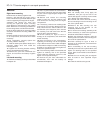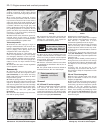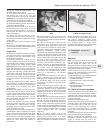
3 Engine/manual transmission
- removal, separation,
reconnection and refitting
4
Removal
Note: The engine can be removed from the car
only as a complete unit with the transmission;
the two are then separated for overhaul.
1 Park the vehicle on firm, level ground.
Chock the rear wheels, then firmly apply the
handbrake. Jack up the front of the vehicle,
and securely support it on axle stands (see
“Jacking and vehicle support”). Remove the
front roadwheels.
2 Set the bonnet in the upright position, and
remove the battery and tray as described in
Chapter 5A.
3 Remove the complete air cleaner assembly
and all inlet ducting, as described in the
relevant Part of Chapter 4.
4 If the engine is to be dismantled, working as
described in Chapter 1, first drain the oil and
remove the oil filter. Clean and refit the drain
plug, tightening it securely.
5 On XU and TU series engines, drain the
transmission oil as described in Chapter 7A.
Refit the drain and filler plugs (as applicable),
and tighten them to their specified torque
settings.
6 Remove the alternator as described in
Chapter 5A.
7 Where applicable, remove the power
steering pump as described in Chapter 10.
Where possible, unbolt the pump and move it
aside without disconnecting the fluid hoses.
8 On models with air conditioning, unbolt the
compressor, and position it clear of the engine.
Support the weight of the compressor by tying
it to the vehicle body, to prevent any excess
strain being placed on the compressor lines
whilst the engine is removed. Do not disconnect
the refrigerant lines from the compressor (refer
to the warnings given in Chapter 3).
9 Drain the cooling system as described in
Chapter 1 then remove the radiator as
described in Chapter 3. Note that it is not
strictly necessary to remove the radiator, but
it does improve clearance, and removes the
risk of damaging the radiator as the engine is
removed. If the radiator is to be left in
position, disconnect the top and bottom
radiator hoses at both ends and remove them
completely. It is also a good idea to place a
sheet of cardboard (or preferably plywood)
between the engine and radiator as protection
against any accidental contact.
10 On carburettor models, carry out the
following operations, using the information
given in the relevant Part of Chapter 4:
a) Disconnect the fuel feed and return hoses.
b) Disconnect the throttle and where
applicable the choke cables from the
carburettor.
c) Where fitted, disconnect the braking
system servo vacuum hose from the inlet
manifold.
d) Disconnect the exhaust system downpipe
from the exhaust manifold and remove
the support brackets or clamps securing it
to the engine or transmission.
11 On fuel injection models, carry out the
following operations, using the information
given in the relevant Part of Chapter 4:
a) Depressurise the fuel system, and
disconnect the fuel feed and return hoses.
b) Disconnect the throttle cable.
c) Disconnect the fuel system wiring
connectors.
d) Disconnect all vacuum hoses from the
inlet manifold.
e) Disconnect the exhaust system downpipe
from the exhaust manifold and remove
the support brackets or clamps securing it
to the engine or transmission.
12 Referring to Chapter 3, release the
retaining clip and disconnect the heater matrix
hoses from their connection on the engine
compartment bulkhead.
13 Working as described in Chapter 6,
disconnect the clutch cable from the
transmission, and position it clear of the
working area.
14 Carry out the following operations, using
the information given in Chapter 7A:
a) Disconnect the gearchange selector
rod/link rods (as applicable) from the
transmission.
b) Disconnect the speedometer cable from
the speedometer drive.
c) Where applicable, release the power
steering pipe from the underside of the
transmission.
d) Disconnect the wiring connector(s) from
the reversing light switch and
speedometer drive (as applicable).
15 Remove both driveshafts as described in
Chapter 8.
16 On some models it will be possible to
remove the engine/transmission complete
with the engine wiring harness left in position.
This saves having to disconnect each
individual wire from its relevant connection
and its retaining clips. Unfortunately this will
not be possible on all models, but where it is,
trace the wiring harness back from the engine
to the wiring connector(s) in the front, left-
hand corner of the engine compartment (see
illustration). Release the locking ring(s) by
Engine removal and overhaul procedures 2D•5
2D
3.16 Typical engine wiring harness connections (XU series fuel injected engine shown)


















